
As the 10th anniversary of the 9/11 attacks on the World Trade Center and Pentagon approaches, I am filled with a whole  mess of thoughts and emotions. 9/11 was a turning point in the United States–and the world–in so many ways. I need not explain what it has meant for us Sikhs in the United States and beyond, but in the coming days and weeks we will try to highlight some of the important initiatives taking place in commemoration of the 10th anniversary that go beyond jingoistic patriotism and provide opportunities for reflection, dialogue, and moving toward healing and justice.
mess of thoughts and emotions. 9/11 was a turning point in the United States–and the world–in so many ways. I need not explain what it has meant for us Sikhs in the United States and beyond, but in the coming days and weeks we will try to highlight some of the important initiatives taking place in commemoration of the 10th anniversary that go beyond jingoistic patriotism and provide opportunities for reflection, dialogue, and moving toward healing and justice.
Today, I was pleasantly surprised to read a compelling, heartfelt column in the Huffington Post about post-9/11 torture practices by the US government — written by a Sikh. In the piece, Satpal Singh, of the World Sikh Council, states:
I must shed the tears that I have been holding back for seven years. It was 1 a.m. on April 29, 2004, and I could not sleep. The beacon that I had always looked up to had gone dark.
I had just heard about Abu Ghraib. It shook my faith in my country’s ability to uphold its values. Admittedly, it takes the strongest of the strong to face the evil that we were facing, and the highest of morality to face it without losing one’s own morality. But now, even America, the mightiest of the mighty, the champion of human rights, the unquestioned upholder of morality, had blinked in the face of evil. The terror had seized us. Faced with evil, we had abandoned our own values.
One of the many tragedies of the American post-9/11 era is that torture has become a routine tactic in the treatment of terrorism suspects. While these policies began during the Bush Administration (see a new report by Human Rights Watch on the subject here), there seems to be much less protest of their continuation under Obama’s presidency. While Obama promised to closed down the infamous Guantanamo detention center during his presidential campaign, it still remains as do Bush/Cheney era interrogation tactics.
Embracing my new role as a proud Chacha, I recently bought some Sikhi-related children’s books for my niece for her first birthday. I was especially excited about this new book and CD of Sikh nursery rhymes called Ik Chota Bacha. The book/CD is a great way to teach basic Sikh values to kids and help develop their Punjabi skills (all the nursery rhymes are in Punjabi) in a fun way. I played the CD for my niece on the daily when I was visiting for her birthday, and by the end of the week, the whole family was singing along to some of the catchy (and rather cheesy) tunes. (See a full review of the book here.)
My excitement about the release Ik Chota Bacha quickly became muddied with disappointment and frustration once I saw the book’s illustrations. Every single Sikh child and adult depicted in the book looks WHITE. I don’t just mean they’re all fair-skinned on the spectrum of brownness. I mean peachy, rosey-cheeked, white.
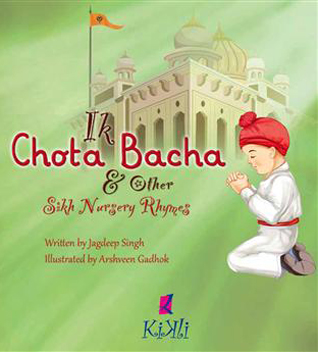
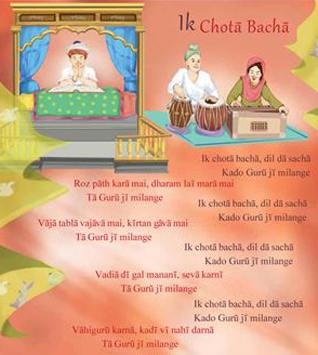
Guest blogged by Eren Londonwala
Each day I walk down Ferry Lanein Tottenham to my workplace. On Friday 5 August a police cordon blocked my usual route. I learned later that police had shot dead 29 year-old alleged gang-member Mark Duggan the night before. The precise facts remain unclear but early reports suggesting an exchange of fire between police and the dead man have been undermined – Duggan’s gun wasn’t discharged. This was a tragedy I thought and perhaps another instance of excessive force by police in a poor London borough with a large black population. Few anticipated what was to come.
route. I learned later that police had shot dead 29 year-old alleged gang-member Mark Duggan the night before. The precise facts remain unclear but early reports suggesting an exchange of fire between police and the dead man have been undermined – Duggan’s gun wasn’t discharged. This was a tragedy I thought and perhaps another instance of excessive force by police in a poor London borough with a large black population. Few anticipated what was to come.
On the next day members of Duggan’s family – who by then had still not been contacted by police – and other locals went to Tottenham Police Station for answers and to stage a peaceful vigil. Senior police ignored the group and around this time a young female, remonstrating, was apparently “set upon by police with their batons”. Unlike a previous contributor to this blog, who described this incident as “relatively minor”, given the understandably heightened passions live then in Tottenham, I feel the police action was heavy-handed and incendiary. I invite readers to view the evidence and make up their own minds. It was after these events that Tottenham, and in subsequent days other areas in London and England, erupted into the worst civil unrest for a generation.
Then, the causes were unmistakeable – racist policing of ethnic minority communities and social deprivation. So, like some others, I viewed the outbreak of recent violence as a reaction to the continuation of unresolved problems, sparked by the suspicious killing of Duggan – an understandable, and even legitimate, rebellion in other words. The fact that police cars were among the first targets of the Molotov bombs seemed to confirm this. Yet, as the days unfolded, and disorder spread throughout the capital and country, a distinction between the two eras became apparent: 2011 was marked, to a far greater degree than 1981, by opportunist looting which came to devastate as many small independent businesses as insured corporate chains and, amid the chaos, most tragically, led to further loss of life with Duggan’s death being all but forgotten.
I have shared my views on Manpreet Badal and the PPP in the past. I still stand by my analysis, but as the election draws nearer, the youth of Punjab are making their voices heard.
Recently Manpreet Badal has been visiting the US this month and gaining more and more popularity among the non-voting NRPs (Non-Resident Punjabis), but if this show of support can be capitalized in Punjab is yet to be seen. His campaign has had a few major hiccups recently, with supporters such as Rajya Sabha member, Varinder Singh Bajwa, being re-wooed by Punjab’s greatest snake-oil seller, Parkash Badal. This loss comes soon after Manpreet had lost the support of his former “right-hand man”, Charanjeet Brar. It has been a long few weeks.
Still amongst a large number of Punjabi youth, they are still showing their support and hope, through creating videos on youtube to help galvanize the youth.
Here is one such example, a parody of rapper Wiz Khalif’a’s celebration of his native Pittsburgh – Black and Yellow. Here the artists – Sugar Cane Records and Jogi – ask who to vote for – Chitta (the color associated with the Congress Party) or Neela (the color associated with the Akali Dal). Both are thieves, the difference only the color.

The issue of sex-selective abortion is not new here in The Langar Hall. A number of our bloggers have commented on this complex issue in the past; and even early community initiatives have been supported as well.
Recently I saw the official trailer of a documentary – It’s A Girl – that promises to look at the issue in China and India.
In India, China and many other parts of the world today, girls are killed, aborted and abandoned simply because they are girls. The United Nations estimates as many as 200 million girls(1) are missing in the world today because of this so-called “gendercide”.
Shot on location in India and China, It’s a Girl! explores the issue. It asks why this is happening, and why so little is being done to save girls and women.
The film tells the stories of abandoned and trafficked girls, of women who suffer extreme dowry-related violence, of brave mothers fighting to save their daughters’ lives, and of other mothers who would kill for a son. Global experts and grassroots activists put the stories in context and advocate different paths towards change, while collectively lamenting the lack of any truly effective action against this injustice.
Currently in post-production, It’s a Girl! is scheduled for an early 2012 release.
I invite our readers to take a look at the trailer and share their comments, as will I.

I was listening to NPR a few nights ago while cooking dinner and was excited to hear about a group of Christian and Catholic clergy in Alabama taking action against a new anti-immigrant law in their state.
A few months ago, Alabama followed in Arizona’s footsteps in passing a bill that many are calling the most sweeping anti-immigrant law in the country, going even farther than Arizona’s highly controversial SB 1070.
Alabama’s new bill, H.B. 56, includes similar provisions to Arizona’s SB 1070, including one that authorizes local police to ask anyone they stop about their immigration status based on “reasonable suspicion,” amounting to the legalization of racial profiling.
[H.B. 56] bars illegal immigrants from enrolling in any public college after high school. It obliges public schools to determine the immigration status of all students, requiring parents of foreign-born students to report the immigration status of their children.
The bill…also makes it a crime to knowingly rent housing to an illegal immigrant. It bars businesses from taking tax deductions on wages paid to unauthorized immigrants. (link)
The law also makes it illegal to enter into a contract with, harbor, or transport undocumented immigrants.
Alabama’s Methodist, Episcopal, and Roman Catholic Churches have sued the state of Alabama over this law, saying it violates their religious freedom. Melissa Patrick of the United Methodist Church of Alabama states, “This new legislation goes against the tenets of our Christian faith — to welcome the stranger, to offer hospitality to anyone.”
 Guestblogged by Mewa Singh.
Guestblogged by Mewa Singh.
A young and vibrant community in the diaspora, it is incumbent upon us to remember our trailblazers. Hari Singh Everest was one such person. I remember reading his name during my undergraduate days. Stumbling across the ‘Sikh Review’, when I should have been completing other studies, it was the first time I had read a literate Sikh journal in English. Skimming the names of editors and contributors on the back, I noticed one from my very own California – Yuba City to be exact. Hari Singh Everest. I didn’t know him, but the unusual last name stuck in my head.
It would be years later when I finally met him. Some years ago the Jakara Movement decided to sponsor the efforts of all the collegitate Californian Sikh Students Associations (SSAs) in building a unity float. Since then, the float at the Yuba City Nagar Kirtan has become an annual affair.. The Everest Family graciously opened their home and it was on one such opportunity that I got to sit down with Hari Singh and speak to him. I mentioned that I had read his name on that Sikh Review issue years ago and he smiled. He talked about his experiences in the Sikh community and as being a sort of ambassador during those early years. It is a conversation I cherish.
His life in the United States stretches back to the 1950s (before the ‘Great Society’ immigration policy of LBJ) and his life in Yuba City goes back to 1961.
UPDATES 8/20/11 as of 12:30pm
The pardhan of the pind Gurdwara tries to state that the whole village apologizes, without giving any specificity as to the culprits or accountability for the action. One Singh in attendance will not stand for it:

Yesterday, Punjabi Radio USA spent an entire show on the issue, interviewing a member of the SGPC as well as some people that have traveled to the village and give their eye-witness testimonials

Still no news on the Tribune India (English) page. There is news on their Punjabi page as well as that of the Ajit and other Punjabi news outlets.
—————————————————-
 If you were looking to attend a Sikh retreat a decade ago, you may have had a difficult time finding one. Thankfully, this is no longer the case. We are now fortunate enough to have a plethora of retreats and conferences to participate in. These retreats offer Sikhs an opportunity to cultivate our spirituality in hopes of moving us forward on our journey, whatever stage we may be at.
If you were looking to attend a Sikh retreat a decade ago, you may have had a difficult time finding one. Thankfully, this is no longer the case. We are now fortunate enough to have a plethora of retreats and conferences to participate in. These retreats offer Sikhs an opportunity to cultivate our spirituality in hopes of moving us forward on our journey, whatever stage we may be at.
For the past several Septembers, I’ve packed up my things and traveled to Santa Cruz to attend Saanjh. Each year, i come back feeling fulfilled and rejuvinated. This year’s Saanjh will be particularly special – the organizers will be offering Amrit Sanchaar for those individuals who are ready to make this commitment. A note from the organizers states:
Photo Credit: Gurumustuk Singh
We are proud to announce that there will be a ‘Khandey Baatey di Paul’/ ‘Amrit Sanchaar’ at Saanjh this year. Khande di Pahul or Amrit is the most spiritually significant event in a Sikh’s life. When one decides to partake in Amrit, she or he makes a commitment to walk the Sikh spiritual path. Amrit is the beginning of a journey, not the end–it’s akin to admission into a school to study a subject matter seriously, not graduation. For those of you who are looking to make the commitment, may we offer Saanjh as the venue for your commitment ceremony.
The retreat will bring together young Sikhs from across North America (and sometimes beyond!) to participate and engage in Sikhi. Whether or not we are ready to take Amrit – Saanjh offers us a unique opportunity to observe and learn about this very special ceremony. The retreat is a venue where we can learn about these significant and important aspects of Sikhi and feel supported as we embrace our individual journeys. The sessions are dynamic and promise to inspire participants. This year’s breakout sessions will include, “Guru and I”, “Poetry is Not a Luxury”, “Vaisakhi of 1699”, “2084: Looking Back, Looking Forward”, and “Gendered Violence and Spirited Sikh Resistance”.
Saanjh is open to all above 18 years of age and will be held this year from September 8th to 11th 2011. Please see the website for more information and register before prices increase! See you there Langarites!

NYC Sikhs speak out against the Transit Authority's religious discrimination in 2009
This morning, the New York City Council voted unanimously to pass the Workplace Religious Freedom Act (Int. 632-A), a bill that will strengthen the city’s human rights law that protects employees from religious discrimination at their jobs.
According to the City Council,
This law will provide greater protection to workers by strengthening the law that requires employers to provide employees with reasonable accommodations for religious observance.
Employers that are found to have engaged in unlawful discriminatory practices against its workers may be liable for a civil penalty of as much as $125,000 and/or be required to pay compensatory damages, award back pay, reinstate employees and extend full and equal accommodations to employees.
The law is of particular significance to turban-wearing Sikhs and hijab-wearing Muslims who have faced a great deal of discrimination in their workplaces in NYC, particularly since 9/11. Advocates including the Sikh Coalition (who played a lead role in pushing for the legislation) hope that the law will make it much harder for employers in both the public and private sectors to discriminate against potential or current Sikh employees. Notably, the New York Police Department still does not allow turban-wearing Sikhs to serve as officers. (There was a case years back involving a Sikh traffic cop, however, who ended up winning and serves with his turban).
Guest blogged by Gurchit Singh. Gurchit is a 16-year-old aspiring activist (in his own words) who submitted this piece (his first) to The Langar Hall. Raksha Bandan was last Saturday, August 13th.
Oh the joys of Raksha Bandan! The air is filled with love, family members are conversing and munching on a plethora of  sweets, hugs and kisses are being ecstatically extended to any and all family members the overemotional-mother can seem to get her loving arms around, and the overall mood in the home is one which many families can only dream of experiencing on a daily basis. Unfortunately, these loving moments only further promote a holiday which demotes women and opposes aspects of Sikhism itself.
sweets, hugs and kisses are being ecstatically extended to any and all family members the overemotional-mother can seem to get her loving arms around, and the overall mood in the home is one which many families can only dream of experiencing on a daily basis. Unfortunately, these loving moments only further promote a holiday which demotes women and opposes aspects of Sikhism itself.
While occupying myself with Facebook and sipping warm milk on the morning of Raksha Bandan, I was going through my daily routine of checking any notifications I may have received from the prior night. After reading many generic Raksha Bandan-related salutations, I finally came across one that actually defined what it was actually aimed at achieving: “Raksha Bandhan is a festival which celebrates the relationship between brothers and sisters. The ceremony involves the tying of a rakhi (sacred thread) by a sister on her brother’s wrist. This symbolizes the sister’s love and prayers for her brother’s well-being, and the brother’s lifelong vow to protect her.” While reading this definition, the two phrases that IMMEDIATELY jumped out at me were “sacred thread”, which conjured an instant connection to one of Guru Nanak Dev Ji’s earliest forms of rebellion against what he believed aimless and biased: the Janeu ( the full Sakhi can be referenced here), and “brother’s lifelong vow to protect her”, which called forth an image of a frail young woman constantly relying on her brother for protection from external occurrences.
We have many songs that remind us of Shaheeds; we acknowledge them in our Ardas; and they are an integral part of our Sikh history. It is a powerful experience to hear how an integral concept in Sikhi manifests in other communities. Specifically the Muslim community, which also adheres to a concept of Shaheedi.
Often times in the media, the concept of Shaheedi has been presented as a form of “brainwashing” done by religious and political leaders to condone terrorism and violence for their own self-interests. However, a recent NPR report highlights how two devote Muslim men from America became Shaheeds out of their own strong will to bring justice back to their home country of Libya.
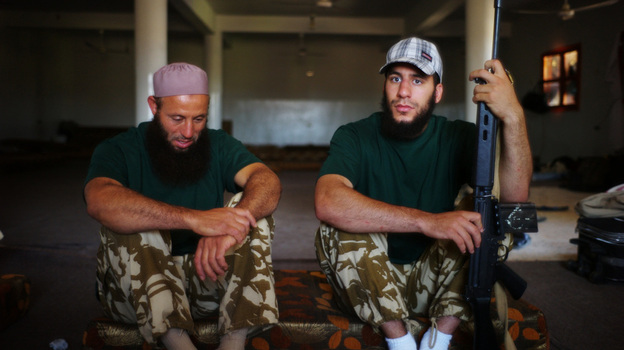
Mabruk Eshnuk (left) and his son Malik (right) left their home in Pittsburgh to volunteer and fight with rebels in western Libya's Nafusa Mountains.
A father and son left their home in Pittsburgh, Pennsylvania (USA) to participate in the Libyan revolution. Mabruk Eshnuk and his 21-year old middle son, Malik Eshnuk, died fighting the forces loyal to Moammar Gadhafi in western Libya.
Mabruk, a devoute Muslim had immigrated from Libya as a teenager. He taught Islam to convicts in the Pennsylvania state penitentiary system. In 2006, he housed the family of a young Iraqi boy who was getting lifesaving treatment in the United States. He said, “Everything that we do and work and help, it’s based on the Quran.” Outraged over what was happening in Libya, he took his middle son to fight in the Western mountains of Libya.
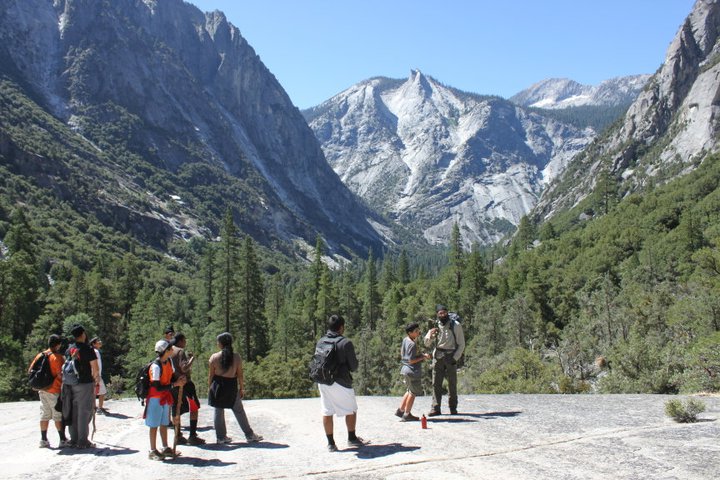 Guestblogged by Mewa Singh.
Guestblogged by Mewa Singh.
Here are some general musings and broader notes/reflections that were sparked by my participation in the camp:
On Parenting – One thing I found quite interesting was changes in parenting styles. I don’t remember having had many choices as a child, when my parents were going to put their foot down, and it seems my own parents confirm this. With the camp, I noticed we had so many parents expressed their desire for their sons to attend, only to begin avoiding our calls as the date approached and telling us our son doesn’t want to go. Many of the same parents often complained – our son doesn’t listen to us and just watches TV all day. I was left wondering, how do these children have the choice? A parent has the ability to parent and limit the child’s television viewing, if they so desire. A parent is not helpless to say our child doesn’t listen so we must accept the status quo. Many parents desire to be the ‘friend’ of their child, or be the ‘good guy/gal’ and never say ‘no.’ With so many of my friends young parents, I wonder how they will be setting boundaries.
On Consumerism – Now members of our community are part of the broader society and one would hardly expect larger sociological issues such as consumerism to not affect us. Still the degrees seem far more now than in my youth. I remember kids having and even getting beat up and their shoes stolen if they had the latest Jordans. With 13-year olds having iPhones, 16-year olds getting BMWs for their birthdays (Jodha had a reflection on this some time ago), and wardrobe prices that went far beyond our $15 jeans from Marshalls, I wonder what are we teaching our children? Ask parents to send their children to a Sikh workshop or even Punjabi/Khalsa school at their Gurdwara and parents will begin about fees being far too high. What do we actually value and what do we wish to teach our children to value?
Guest-blogged by Mewa Singh. Mewa Singh is a sevadar with the Jakara Movement.
Reviving and reinterpreting our historic terminology were part of the naming process of this unique camp.
With the Guru’s Grace, from August 1-10, I had the opportunity to be a sevadar for the Jakara Movement’s first annual Bhujangi Youth Academy. Unlike anything else in our community before, the academy specifically served the needs of at-risk young Punjabi Sikh males.
Yes, we disagree. Yes, most of you even fight amongst yourselves. Our voices and opinions are as diverse as the people in our community. So be it. This is how we learn from one another.
Sometimes you challenge us (the bloggers). Most of the time you challenge each other (the commenters). Do I wish the level of discussion with each other could be raised? At times, yes. Do I appreciate that you take the time to engage? ABSOLUTELY! Why? Because you care enough about the community, about Gurbani, about our collective future to engage.
Guest blogged by Naujawani Sardar
When the riots began in London last Saturday, we all thought they were a one-off incident and the world would be back to normal by Monday. Instead we awoke to find that more shops had been looted, buildings were still being set ablaze and that the rioters were now widening their search for new canvases to destruct. The thought was certainly there in the back of my mind, throughout my working day on Monday, but I think I purposely ignored it, hoping that it just would not happen: could a gurdwara be targeted?
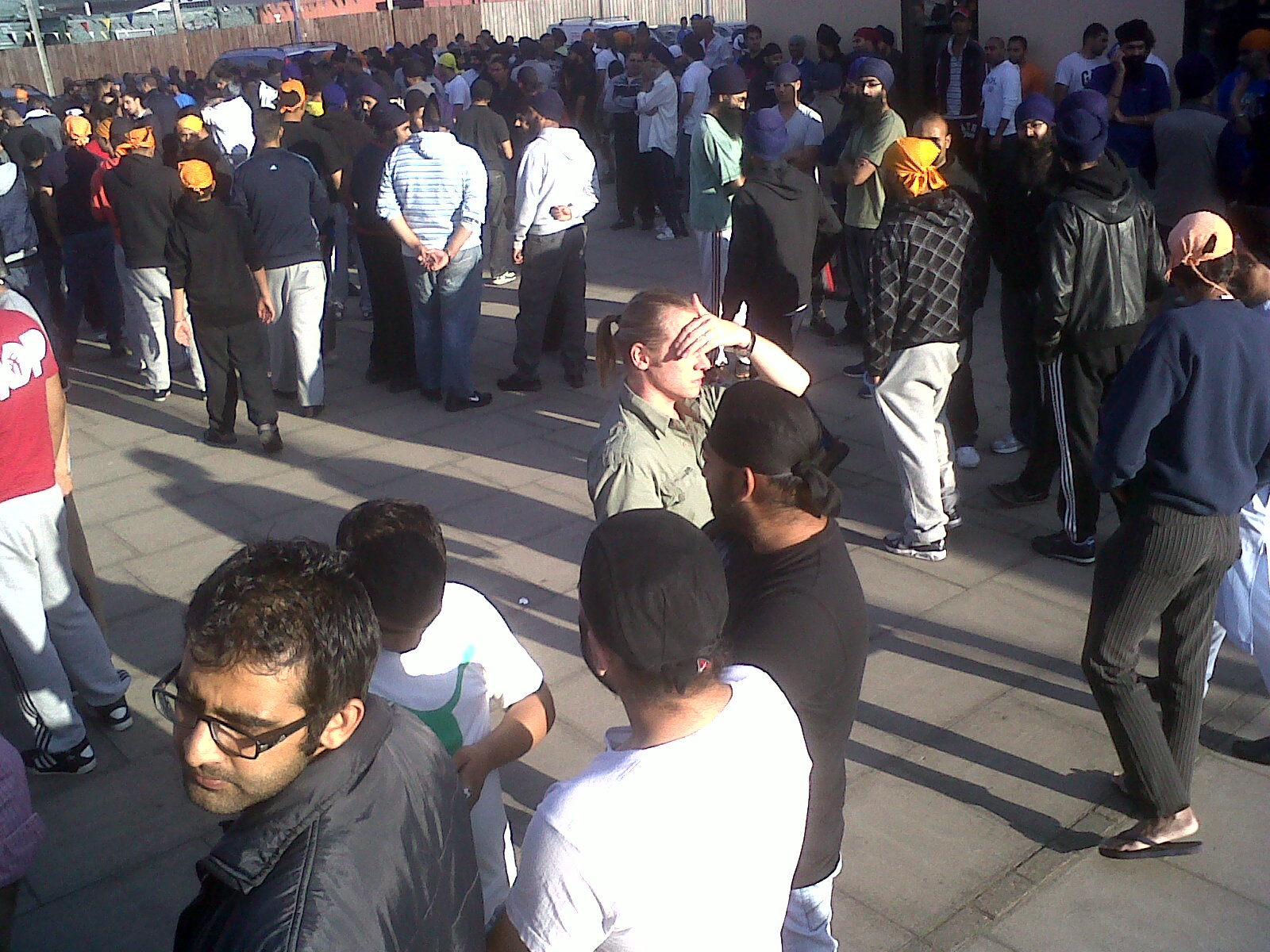 A small number of Sikhs however did not let the thought fall out of sight and continued to monitor the situation. Having realised that a problem may arise, albeit very late at night, they spent the best part of the night driving across London from one Gurdwara to the next to ensure that there was adequate security in place. Where there was not, one man stayed behind or where possible, awoke a local friend to come in. Thus was sewn the seed for a collaborative effort from a number of individuals to coordinate Sikhs that wanted to defend their Gurdware. Throughout Tuesday, Facebook, Twitter and SMS text messages were used to inform and mobilise people into preparing for the night(s) ahead. We at Naujawani also played a small role in coordinating these efforts and garnering support from individuals which personally gave me a greater insight into how things developed over the last 48 hours. It was clear to a few of us that if we were to have any success, people had to be appropriately distributed to different Gurdware. In west London, Southall is naturally the hub and meeting point, but throughout the rioting other Gurdware to the north and east of London were at a higher risk.
A small number of Sikhs however did not let the thought fall out of sight and continued to monitor the situation. Having realised that a problem may arise, albeit very late at night, they spent the best part of the night driving across London from one Gurdwara to the next to ensure that there was adequate security in place. Where there was not, one man stayed behind or where possible, awoke a local friend to come in. Thus was sewn the seed for a collaborative effort from a number of individuals to coordinate Sikhs that wanted to defend their Gurdware. Throughout Tuesday, Facebook, Twitter and SMS text messages were used to inform and mobilise people into preparing for the night(s) ahead. We at Naujawani also played a small role in coordinating these efforts and garnering support from individuals which personally gave me a greater insight into how things developed over the last 48 hours. It was clear to a few of us that if we were to have any success, people had to be appropriately distributed to different Gurdware. In west London, Southall is naturally the hub and meeting point, but throughout the rioting other Gurdware to the north and east of London were at a higher risk.
Guest blogged by Naujawani Sardar
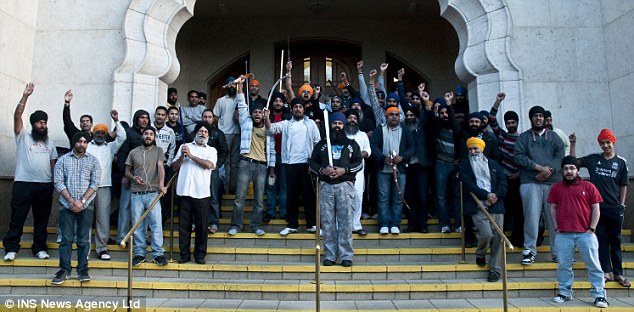 Riots have hit London and a few other cities in the UK over the last three nights causing mayhem, destroying property and leading to looting. Tonight, hundreds of Sikhs are gathering to defend the Gurdware in these cities should they fall under the eye of the looters. It is bringing together Sikhs of all backgrounds and affiliations; promising a glimmer of hope from an otherwise horrible situation.
Riots have hit London and a few other cities in the UK over the last three nights causing mayhem, destroying property and leading to looting. Tonight, hundreds of Sikhs are gathering to defend the Gurdware in these cities should they fall under the eye of the looters. It is bringing together Sikhs of all backgrounds and affiliations; promising a glimmer of hope from an otherwise horrible situation.
To find out more about this mobilisation of Sikhs, go to the Sikh Riot Awareness UK page.
The trigger has been widely recognised as the shooting of a 29 year old black man Mark Duggan in the Tottenham area of North London. 48 hours after his shooting, members of his family, friends and the wider community congregated outside Tottenham Police Station to protest at what they saw as the heavy-handed action of the London Metropolitan Police and the unhelpful communication from them about the matter in the following days. At this gathering of about some 300 protestors, a relatively minor confrontation between a teenager and the Police is said to have ignited running battles that ensued well into the night. A double decker bus was set alight and 49 fires were being dealt with by morning. But more importantly, as a sign of things to come, shops selling household goods, sportswear, toiletries and glasses were looted with CCTV images capturing hooded individuals taking away trollies laden with items.
Along with the start of the holy month of Ramadan, the last few weeks have seen an increase in momentum for laws that ban the wearing of the burqa and niqab in European 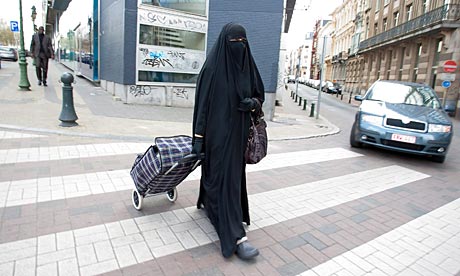 countries. We’ve talked about France before, where the implementation of its law banning Muslim face covering began this past spring. Now Belgium, which passed a similar measure last year, has begun implementing its ban on burqas as of July 23rd, and in Italy, new anti-burqa legislation was just passed by a parliamentary commission this week.
countries. We’ve talked about France before, where the implementation of its law banning Muslim face covering began this past spring. Now Belgium, which passed a similar measure last year, has begun implementing its ban on burqas as of July 23rd, and in Italy, new anti-burqa legislation was just passed by a parliamentary commission this week.
In both countries, like France, a miniscule number of women actually wear the burqa or niqab, begging the question of why an increasing number of European nations feel so threatened by it.
In Belgium, the lawmaker who proposed the bill, Daniel Bacquelaine, “said it was necessary to forbid the wearing of clothes that ‘totally mask and enclose’ the wearer. He described wearing the burqa as ‘not compatible with an open, liberal, tolerant society.’ Peter DeDecker of the Flemish separatist NVA saw the ban as a way of defending ‘our fundamental principles of the enlightenment.'”
Just as in France, what I would argue (and have previously argued) is an attack on religious freedom is being justified with the rhetoric of freedom and liberty (and public safety).
I love books – but I have a special, and perhaps curious, interest in books by and about Sikhs. Perhaps it’s the fascination to discover how similar or different our experiences are. I’m convinced i’m not alone in this. There has been an established interest in South Asian literature for quite some time, but now – with the growing number of authors covering the British Sikh or North American Sikh experience – there is piqued enthusiasm in diasporic “Sikh Literature”. I think it’s important to support this type of work – not simply because the author is Sikh or writes about Sikhs – but because until we have enough of this representation in literature, we need to encourage it’s growth. This also means that authors will be faced with higher expectations from their readers who want authentic stories, sophisticated writing and dymanic story telling – just as we’d expect from any other piece of literature.
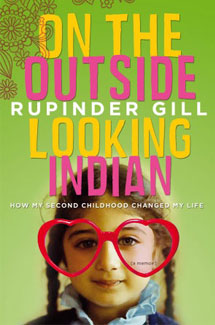 I recently read Rupinder Gill’s memoir, On the Outside Looking Indian. The premise and cover of the book attracted me, perhaps because it reminded me of Sathnam Sanghera’s, If You Don’t Know Me By Now – a book I highly recommend. Gill’s memoir, similar to Sanghera’s, deals with her personal experience growing up as the child of immigrants. Gill’s story is set in Canada and focuses on her year-long quest, at the age of about 30, to fulfill a list of her childhood dreams — learning to swim, going to Disney World, and living in New York etc – activities she didn’t participate in as a child. I found Gill’s descriptions of her childhood to be well-written, funny and often relatable.
I recently read Rupinder Gill’s memoir, On the Outside Looking Indian. The premise and cover of the book attracted me, perhaps because it reminded me of Sathnam Sanghera’s, If You Don’t Know Me By Now – a book I highly recommend. Gill’s memoir, similar to Sanghera’s, deals with her personal experience growing up as the child of immigrants. Gill’s story is set in Canada and focuses on her year-long quest, at the age of about 30, to fulfill a list of her childhood dreams — learning to swim, going to Disney World, and living in New York etc – activities she didn’t participate in as a child. I found Gill’s descriptions of her childhood to be well-written, funny and often relatable.
Without a doubt, many of us can relate to childhoods of inactivity – unless activity consisted of housework – then no, we really didn’t participate in many activities, especially compared to how busy and structured the lives of children are today. There are obvious exceptions to this, however, this is most likely a common experience for many. While Gill’s story is framed around a Panjabi Sikh household, it’s clear that her experiences could be those of many first-generation children whose parents have emigrated to new lands.
My childhood was full of insecurity and self-doubt, the result of years of harassment, taunts, and jokes about the ball/rag/tomato/towel/etc. on my head as a turban-wearing child. My insecurities, however, began to shift (or expand) as puberty hit. Let’s call it facial hair anxiety.
At first, having a moustache grow in at a young age wasn’t necessarily a bad thing. After all, I passed as much older than I was, which was nice for a scrawny brown kid like me.
But soon enough, the complex around my dhari (beard) settled in, and no amount of time with a thatha tied tightly  around my head was ever enough to totally alleviate my beard insecurities.
around my head was ever enough to totally alleviate my beard insecurities.
Surrounded by peers for whom shaving was a rite of passage into manhood, it’s not surprising that I felt a little left out (though to be clear, the idea of a razor on my face never sounded so pleasant). Further, I was inundated with the voices of young women in my school casually referring to facial hair as gross or unattractive (with no intention to hurt my feelings I’m sure) and their preference for guys who were “clean-shaven.”
CLEAN-shaven. The implication being that facial hair is…dirty?
These are the messages we get from our peers and from the media every day. So naturally I assumed it was highly unlikely that any of my female classmates would ever be interested in dating someone like me. The combination of a dirty face plus a patka was enough to cause a whole lot of anxiety and insecurity for this angsty teenage Singh.


